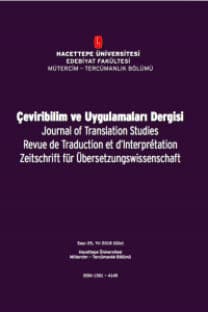Kent Mekânında Bir Çeviri Biçimi Olarak Sokak Sanatı
çeviri, çeviri kent, kentsel müdahale, sokak sanatı, kültürel aracılar
Street Art as a Form of Translation in the Urban Space
street art, translational city, urban intervention, cultural mediators,
___
- Ayhan, A. (2019). Kentsel müdahalenin çeviri etkinliği bağlamında kavramsallaştırılması: Bir çeviri bölgesi olarak Yeldeğirmeni mahallesi [Yayımlanmamış Doktora Tezi]. Yıldız Teknik Üniversitesi, Sosyal Bilimler Enstitüsü, İstanbul.
- Ayhan, A., & Bogenç-Demirel, E. (2018). Understanding urban intervention as a translational activity: A case of the Yeldeğirmeni neighborhood. Translation Spaces, 7(2), 202-219.
- Barthes, R. (1993). Göstergebilimsel serüven (M. Rifat & S. Rifat, Çev.). Yapı Kredi Yayınları.
- Batmankaya, M. (2010). Marmara’da bir balık olarak Haydarpaşa. Heyamola Yayınları.
- Bhabha, H. K. (1994). The location of culture. Routledge.
- Buden, B., Nowotny, S., Simon S., Bery A., & Cronin M. (2009). Cultural translation: An introduction to the problem, and responses. Translation Studies, 2(2), 196-219. https://doi.org/10.1080/14781700902937730
- Cameron, S., & Coaffee J. (2005). Art, gentrification and regeneration – From artist as pioneer to public art. European Journal of Housing Policy. 5(1), 39-58. https://doi.org/10.1080/14616710500055687
- Cronin, M. (2006). Translation and identity. Routledge.
- Cronin, M., & Simon, S. (2014). Introduction: The city as translation zone. Translation Studies, 7(2), 119–132. https://doi.org/10.1080/14781700.2014.897641
- Douay, N. (2012). L‟activisme urbain à Montréal: des luttes urbaines à la revendication d‟une ville artistique, durable et collaborative. L’Information géographique. 76, 83-96. https://10.3917/lig.763.0083 Eco, U. (2004). Mouse or rat? Translation as negotiation. Phoneix.
- Giz. A. (1998). Bir zamanlar Kadıköy. İletişim Yayınları.
- Gouanvic, Jean-Marc. 2005. A Bourdieusian theory of translation, or the coincidence of practical instances: Field, “habitus, capital and illusio‟. The Translator. 11(2), 147-166. https://doi.org/10.1080/13556509.2005.10799196
- Kayacan, F. (2008). Çocuktaki bahçe (İlk basım 1982). YKY.
- Klanten R., Ehmann S., Hellige H., & Alonzo P. (2008). The upset: Young contemporary art. Die Gestalten Verlag.
- Kütükçü, T. (2014). Kadıköy’ün kitabı. Ötüken Yayınları.
- Lemoine, S., & Ouardi S. (2010). Art, action politique et résistance culturelle. Éditions Alternatives.
- Lindgaard, J. (2005, Nisan 2). Artivisme. Vacarme 31. http://www.vacarme.org/article1269.html
- Maitland, S. (2017). What is cultural translation?. Bloomsbury.
- McCormick, C., Schiller M., & Schiller S. (2010). Trespass: A history of uncommissioned urban art. Taschen.
- Meylaerts, R. & Gonne M. (2014). Transferring the city – transgressing borders: Cultural mediators in Antwerp (1850–1930). Translation Studies 7(2), 133-151. https://doi.org/10.1080/14781700.2013.869184
- Nguyen, P. & Mackenzie S. (2010). Beyond the street: With the 100 most important players in urban art. Die Gestalten Verlag.
- Pym, A. (2014). Exploring translation studies. Routledge.
- Simon, S. (2012). Cities in translation: Intersections of language and memory. Routledge.
- Sturge, K. (2009). Cultural translation. M. Baker & G. Saldanha (Ed.), Routledge encyclopedia of translation studies içinde (ss. 67-70). Routledge.
- Suchet, M., & Mekdjian, S. (2016). Artivism as a form of urban translation: An indisciplinary hypothesis. S. Simon (Ed.), In speaking memory: How translation shapes city life içinde (ss. 220-248). McGill-Queen’s University Press.
- Wolf, M., (2002). Culture as translation – and beyond. Ethnographic models of representation in translation studies. T. Hermans (Ed.). Crosscultural transgressions. Research models in translation studies II: Historical and ideological issues içinde (ss. 180-192). St. Jerome.
- Yayın Aralığı: Yılda 2 Sayı
- Başlangıç: 1991
- Yayıncı: Hacettepe Üniversitesi
Gramsci’nin Hegemonya Kavramı Bağlamında Kültürel Öğelerin Çevirisi
Covid-19’un Beden Terim İlişkiselliğinde Çevirisi: ekşisözlük Örneği
Aslı Özlem TARAKCIOĞLU, Hümeyra ALTUNTAŞ KIRAN
Kültürel İmgelerin Dönüşümü: Felâtun Bey ile Râkım Efendi’nin İngilizce Yolculuğu
Diliçi Çeviriler, Yanmetinler ve Normlar Odağında Tarihsel Roman Çevirileri: The Talisman Örneği
Çeviri Projelerinde Süreç: Engelsiz Erişim Örneği
Şirin OKYAYUZ, Sinem SANCAKTAROĞLU BOZKURT
Çeviri Eğitiminde Proje Temelli Bir Uygulama: Barış İçin Müzik Vakfı ve Altyazı Çevirisi
Türkiye'deki Mahkeme Çevirmenliğinin Çevirmen Meslek Standardı Açısından Değerlendirilmesi
